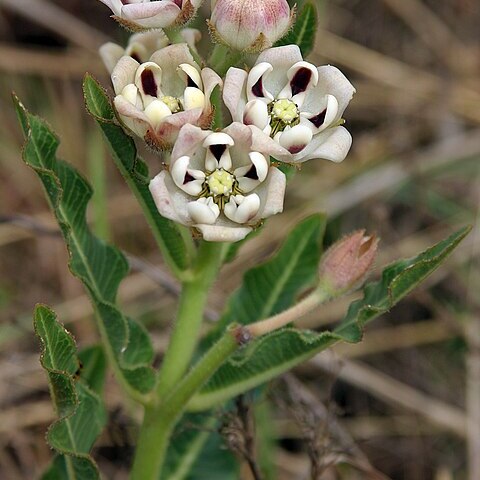Stem 200-400(-560) mm tall, slender to stout, branched at the base or unbranched, sometimes more than one branch arising from a single rootstock, puberulous to pubescent or ± scabrous, hairs frequently arranged bifariously. Leaves ascending-spreading; petiole 3-15 mm long; blade (37-)49-121 x 7-43 mm, linear-lanceolate or lanceolate to narrowly ovate or rarely narrowly elliptic, margins usually undulating, scabrous or pubescent-scabrous, glabrous to pubescent above, puberulous, pubescent or scabrous below, midvein scabrous. Inflorescence umbellate, 2-6-flowered, pedunculate, lateral at nodes (usually upper nodes) and terminal; peduncles 5-65(-90) mm long, pubescent, hairs sometimes bifariously arranged. Bracts 3-18 mm long, narrowly linear or subulate, acute or ± acuminate, glabrous above, pubescent below. Pedicels 10-30(-45) mm long, pubescent, hairs sometimes bifarious. Sepals 9-2 x 3-7.7(-9.2) mm, lanceolate, narrowly ovate or ovate, tips acute or acute-acuminate, pubescent below, glabrous above or rarely pubescent-scabrous towards apex. Corolla (10-)14-26 mm long, cupshaped, lobed almost to the base, white or cream and purple-tinted at the tips on the back, glabrous or rarely covered with minute soft velvet hairs above, glabrous to pubescent below; lobes 11-24 x 8-14 mm, narrowly ovate or ovate-elliptic to elliptic or broadly ovate, apex acute or obtuse, sometimes notched, usually recurved, margins may be slightly revolute towards apex and usually imbricate below. Corona lobes 9-15 mm long, white or pale lemon-yellow with a violet-purple stripe down the inner face, basal part shortly horizontal, linear-oblong or rarely orbicular, 1.4-5 mm broad, bearing 2 contiguous, deltoid or subdeltoid, erect keels, 1-3.1 x 1-4 mm, apex acute or obtuse, usually forming a groove along the middle of the upper surface of the lobe; beyond the keels the lobe curves up, to stand erect or inclined slightly inwards, the tip dilated into an orbicular, concave hood, rarely ± spathulate, 3.5-8.3 mm broad, apex obtuse. Anther wings 2.5-3.8 mm long, ± oblique, outer margin ± straight or concave with basal angle curving outwards; appendages 1.5-3.0 mm long, broadly ovate, obtuse or acute apex indexed over and covering style apex. Follicles 80-110(-135) x 20-30 mm, narrowly ovoid, obtuse, glabrous, 6-winged, wings narrow or prominent.
More
Perennial herb, 200-400 mm high. Leaves with margins of blade undulate. Flowers: inflorescence pedunculate; corona lobes with a pair of prominent, short, erect keels on inner surface, without auricles, apical part orbicular or suborbicular, concave, hood-like and upcurved, white or pale lemon-yellow with violet-purple stripe down inner face; corolla cup-shaped, white or cream-coloured and purple-tinted at tips on back; Sep.-Jan., Jun. Fruit a follicle.
Perennial herb, 200-400 mm tall. Leaf margins undulate. Corolla cup-shaped. Corona lobes with a pair of prominent short, erect keels on inner surface, without auricles, apical part orbicular or suborbicular, concave, hood-like and upcurved. Flowers white or cream and purple-tinted at tips on back; corona white or pale lemon-yellow with violet-purple stripe down inner face.

